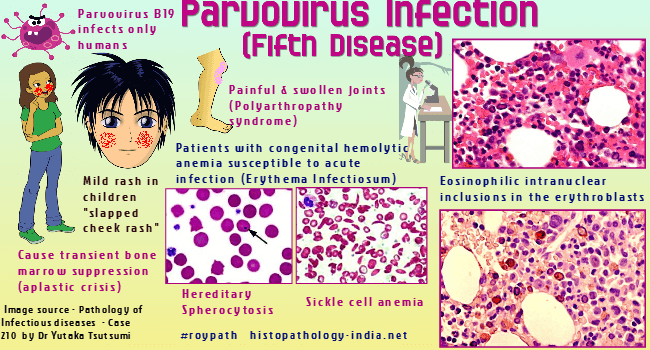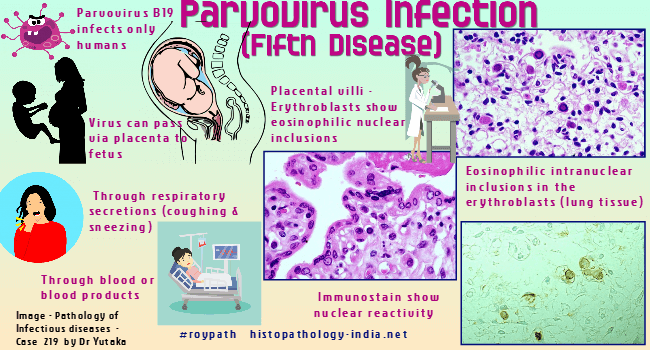|

Custom Search
|
|
Infectious Disease Online Pathology of Parvovirus B19 Infection
|

|
Human parvovirus is a member of the family Parvoviridae, a group of single-stranded DNA viruses. Parvovirus B19 is the type most often implicated in human disease. Lesions caused by Parvovirus: Lesions in the Placental tissue: The placental tissue looks hypercellular on the low power. It is mid-trimester in type, without vasculosyncytial membranes. The cellularity is partly an excess of Hofbauer cells, and partly the prominent nucleated blood cells in the villous vessels. These are erythroid precursors (pronormoblasts) with purple homogeneous intranuclear viral inclusions. This picture is pathognomonic of B19 parvovirus infection. Transplacental infection in early pregnancy infects the erythroblasts and causes fetal anaemia, and hydrops.
Hematological lesions: It also produces a transient red cell hypoplasia via marrow infection. In normal people this is of little consequence, but in haemolytic anaemia it may induce fatal aplasia - Example: Aplastic crisis in sickle cell disease. Parvovirus B19 is also a cause of haemophagocytic syndrome. Skin lesions : Purpura, vasculitis, erythema multiforme, dermatomyositis , a sweet’s syndrome-like eruption, lupus erythematosus-like syndromes, an asymptomatic papular eruption, livedo reticularis, acral pruritus, the papular- purpuric (petechial) "gloves-and-socks" syndrome and erythema infectiosum (fifth disease). Erythema infectiosum (fifth disease): Parvovirus infections causes erythema infectiosum in children (fifth disease). Erythema infectiosum (fifth disease) is an exanthem which may be difficult to distinguish from rubella. A well demarcated rash often appears on the face a few days after the onset of prodromal symptoms. The ill child typically has a "slapped-cheek" rash on the face and a lacy red rash on the trunk and limbs. Occasionally, the rash may itch. The rash usually becomes more generalized after a few days. It is accompanied by low-grade fever, malaise, or a 'cold' a few days before the rash breaks out. Papular-purpuric "gloves-and-socks" syndrome: It is a self-limited infection characterized by pruritic, erythematous papules with petechiae and edema involving predominantly the hands and feet. Fever, arthralgias and oral lesions may be present. This exanthem usually occurs in adults. Immunocompromised patients : People who have leukemia or cancer, who are born with immune deficiencies, who have received an organ transplant, or who have human immunodeficiency virus (HIV) infection are at risk for serious illness due to parvovirus B19 infection. In immunocompromised patients, persistent skin lesions and anemia often develop. Mode of infection: Parvovirus B19 is spread by a respiratory droplet. Incubation period: Incubation period of 5-14 days. Diagnosis: Serological confirmation may be used to confirm the diagnosis. The receptor for the virus is the erythrocyte P antigen which is also expressed on endothelial cells. The virus has been demonstrated in endothelial cells in lesional skin by several methods, including PCR. It has also been identified in keratinocytes. Approximately 50% of the adult population is immune. Histopathology: - Mild perivascular infiltrate of lymphocytes together with exocytosis of lymphocytes and mild basal vacuolar change. - Apoptotic keratocytes may be present. - Extravasaytion of red cells. - Eosinophils and occasional neutrophils may be present. - Changes resembling incomplete granuloma annulare may be present. This may be a late manifestation of a previous lymphocytic vasculitis. It is characterized by a hypercellular interstitium ("busy" dermis) and mucin.
|
|
|
Copyright © 2021 histopathology-india.net


